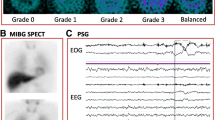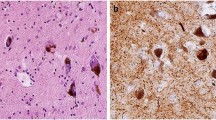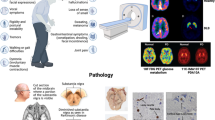Abstract
Lewy body disease (LBD) is a neurodegenerative disease resulting in dementia. It shares clinical and pathological features with Parkinson disease (PD), the most frequent synucleinopathy, Parkinson disease dementia (PDD), and Alzheimer disease (AD), a tauopathy. Even though the diagnostic criteria for these neurodegenerative diseases are clearly established, and recently revised for LBD, their precise clinical diagnosis is often difficult because LBD, PD, PDD, and AD share epidemiological, clinical, and pathological characteristics. This manuscript discusses current understanding of overlapping symptoms and the particular features of LBD, PD, and AD. It also describes features that could facilitate the diagnosis of each of these diseases. We concluded that the concept of neurodegenerative “overlap” syndrome, which includes the accepted diagnosis of LBD, may be taken in account and should contribute to clarifying LBD and definitions of close differential diagnoses. This should allow clinicians to suspect LBD at an earlier stage and provide better patient care.
Similar content being viewed by others
References
Papers of particular interest, published recently, have been highlighted as: • Of importance •• Of major importance
Geser F, Wenning GK, Poewe W, McKeith I. How to diagnose Lewy body disease: state of the art. Mov Disord. 2005;20(Suppl 12):S11–20.
McKeith I, Mintzer J, Aarsland D, Burn D, Chiu H, Cohen-Mansfield J, et al. Lewy body disease. Lancet Neurol. 2004;3:19–28.
Weisman D, McKeith I. Lewy body disease. Semin Neurol. 2007;27(1):42–7.
•• Foguem C, Kamsu-Foguem B. Neurodegeneration in tauopathies and synucleinopathies. Rev Neurol (Paris). 2016;172(11):709–14. Foguem and Kamsu-Foguem described the physiopathology (accumulation of one or more aggregated proteins as the molecular signature) of the three main disease groups constituting the majority of neurodegenerative diseases as tauopathies (Alzheimer’s disease), alpha-synucleinopathies (Parkinson’s disease) and diseases due to repetitions of glutamine (Huntington’s disease). They suggested that in the future, innovative strategies to elaborate suitable diagnostic and therapeutic approaches for neurodegenerative diseases would be found.
McKeith IG, Boeve BF, Dickson DW, Halliday G, Taylor JP, Weintraub D, et al. Diagnosis and management of dementia with Lewy bodies: Fourth consensus report of the DLB Consortium. Neurology. 2017;89(1):88–100.
McKeith IG, Galasko D, Kosaka K, Perry EK, Dickson DW, Hansen LA, et al. Consensus guidelines for the clinical and pathologic diagnosis of Lewy body disease (LBD): report of the consortium on LBD international workshop. Neurology. 1996;47(5):1113–24.
McKeith IG, Dickson DW, Lowe J, Emre M, O'Brien JT, Feldman H, et al. Diagnosis and management of Lewy body disease: third report of the LBD Consortium. Neurology. 2005;65(12):1863–72.
Nelson PT, Jicha GA, Kryscio RJ, Abner EL, Schmitt FA, Cooper G, et al. Low sensitivity in clinical diagnoses of Lewy body disease. J Neurol. 2010;257(3):359–66.
Mollenhauer B, Förstl H, Deuschl G, Storch A, Oertel W, Trenkwalder C. Lewy body and parkinsonian dementia: common, but often misdiagnosed conditions. Dtsch Arztebl Int. 2010;107(39):684–91.
Bianchi AJ, Guépet-Sordet H, Manckoundia P. Changes in olfaction during ageing and in certain neurodegenerative diseases: up-to-date. Rev Med Interne. 2015;36(1):31–7.
Perl DP, Olanow CW, Calne D. Alzheimer’s disease and Parkinson’s disease: distinct entities or extremes of a spectrum of neurodegeneration? Ann Neurol. 1998;44(3 Suppl 1):S19–31.
McKeith IG. Lewy body disease. Br J Psychiatry. 2002;180:144–7.
Waters CH. Lewy body disease: diagnosis and management of Parkinson’s disease. Prof Commun. 2008:76–7.
Boot BP, McDade EM, McGinnis SM, Boeve BF. Treatment of dementia with Lewy bodies. Curr Treat Options Neurol. 2013;15(6):738–64.
Boot BP. Comprehensive treatment of dementia with Lewy bodies. Alzheimers Res Ther. 2015;7(1):45.
Kurtz AL, Kaufer DI. Dementia in Parkinson’s disease. Curr Treat Options Neurol. 2011;13:242–54.
Ince PG, Perry EK, Morris CM. Lewy body disease: a distinct non-Alzheimer dementia syndrome? Brain Pathol. 1998;8(2):299–324.
Ferchichi S, Giraud M, Smagghe A. La démence à corps de Lewy. Rev Gériatr. 2000;25(7):493–8.
Mrak RE, Griffin WS. Lewy body disease: definition, diagnosis, and pathogenic relationship to Alzheimer’s disease. Neuropsychiatr Dis Treat. 2007;3(5):619–25.
Ring HA, Serra-Mestres J. Neuropsychiatry of the basal ganglia. J Neurol Neurosurg Psychiatry. 2002;72(1):12–21.
Chen Y, Garcia GE, Huang W, Constantini S. The involvement of secondary neuronal damage in the development of neuropsychiatric disorders following brain insults. Front Neurol. 2014;5:22.
Metzler-Baddeley C. A review of cognitive impairments in Lewy body disease relative to Alzheimer’s disease and Parkinson’s disease with dementia. Cortex. 2007;43(5):583–600.
Forno LS, Barbour PJ, Norville RL. Presenile Lewy body disease and neurofibrillary tangles. Arch Neurol. 1978;35(12):818–22.
•• Peelaerts W, Bousset L, Van der Perren A, Moskalyuk A, Pulizzi R, Giugliano M, et al. α-Synuclein strains cause distinct synucleinopathies after local and systemic administration. Nature. 2015;522(7556):340–4. Peelaerts et al. studies misfolded protein aggregates which represent a continuum with overlapping features in neurodegenerative diseases, but differences in protein components and affected brain regions. They demonstrated that distinct α-SYN strains display differential seeding capacities, inducing strain-specific pathology and neurotoxic phenotypes.
Galasko D, Saitoh T, Xia Y, Thal LJ, Katzman R, Hill LR, et al. The apolipoprotein E allele epsilon 4 is overrepresented in patients with the Lewy body variant of Alzheimer’s disease. Neurology. 1994;44:1950–1.
Griffin WST, Liu L, Li Y, Mrak RE, Barger SW. Interleukin-1 mediates Alzheimer and Lewy body pathologies. J Neuroinflammation. 2006;3:5.
Bohnen NI, Albin RL. The cholinergic system and Parkinson disease. Behav Brain Res. 2011 Aug 10;221(2):564–73.
McKeith IG, Burn DJ, Ballard CG, Collerton D, Jaros E, Morris CM, et al. Lewy body disease. Semin Clin Neuropsychiatry. 2003;8(1):46–57.
Nagahama Y, Okina T, Suzuki N, Matsuda M. Neural correlates of psychotic symptoms in Lewy body disease. Brain. 2010;133(Pt 2):557–67.
Tröster AI. Neuropsychological characteristics of Lewy body disease and Parkinson’s disease with dementia: differentiation, early detection, and implications for “mild cognitive impairment” and biomarkers. Neuropsychol Rev. 2008;18(1):103–19.
Rolinski M, Fox C, Maidment I, McShane R. Cholinesterase inhibitors for Lewy body disease, Parkinson’s disease dementia and cognitive impairment in Parkinson’s disease. Cochrane Database Syst Rev. 2012;3:CD006504.
Aarsland D, Litvan I, Salmon D, Galasko D, Wentzel-Larsen T, Larsen JP. Performance on the dementia rating scale in Parkinson’s disease with dementia and Lewy body disease: comparison with progressive supranuclear palsy and Alzheimer’s disease. J Neurol Neurosurg Psychiatry. 2003;74(9):1215–20.
Noe E, Marder K, Bell KL, Jacobs DM, Manly JJ, Stern Y. Comparison of Lewy body disease to Alzheimer’s disease and Parkinson’s disease with dementia. Mov Disord. 2004;19(1):60–7.
Vieira RT, Caixeta L, Machado S, Caxeita M. Dementia in Parkinson’s disease: a clinical review. Am J Neurosci. 2011;2(1):35–47.
Folstein MF, Folstein SE, McHugh PR. “Mini-mental state”. A practical method for grading the cognitive state of patients for the clinician. J Psychiatr Res. 1975;12(3):189–98.
Bezdicek O, Michalec J, Nikolai T, Havránková P, Roth J, Jech R, et al. Clinical validity of the Mattis Dementia Rating Scale in differentiating mild cognitive impairment in Parkinson’s disease and normative data. Dement Geriatr Cogn Disord. 2015;39(5–6):303–11.
Marson DC, Dymek MP, Duke LW, Harrell LE. Subscale validity of the Mattis Dementia Rating Scale. Arch Clin Neuropsychol. 1997;12(3):269–75.
Dubois B, Slachevsky A, Litvan I, Pillon B. The FAB: a frontal assessment battery at bedside. Neurology. 2000;55(11):1621–226.
Knopman DS, DeKosky ST, Cummings JL, Chui H, Corey-Bloom J, Relkin N, et al. Practice parameter: diagnosis of dementia (an evidence-based review). Report of the Quality Standards Subcommittee of the American Academy of Neurology. Neurology. 2001;56(9):1143–53.
Bibl M, Esselmann H, Lewczuk P, Trenkwalder C, Otto M, Kornhuber J, et al. Combined analysis of CSF tau, Aβ42, Aβ1–42% and Aβ1–40% in Alzheimer’s disease: Lewy body disease and Parkinson’s disease dementia. Int J Alzheimers Dis. 2010.
Blennow K, Hampel H. CSF markers for incipient Alzheimer’s disease. Lancet Neurol 2003; 2 (10): 605–613.
Andersson M, Zetterberg H, Minthon L, Blennow K, Londos E. The cognitive profile and CSF biomarkers in Lewy body disease and Parkinson’s disease dementia. Int J Geriatr Psychiatry. 2011;26(1):100–5.
von Gunten A, Meuli R. Delineating Lewy body disease: can magnetic resonance imaging help? Front Neurol Neurosci. 2009;24:126–34.
Lee JE, Park HJ, Park B, Song SK, Sohn YH, Lee JD, et al. A comparative analysis of cognitive profiles and white-matter alterations using voxel-based diffusion tensor imaging between patients with Parkinson's disease dementia and Lewy body disease. J Neurol Neurosurg Psychiatry. 2010;81(3):320–6.
Tsuboi Y, Uchikado H, Dickson DW. Neuropathology of Parkinson’s disease dementia and Lewy body disease with reference to striatal pathology. Parkinsonism Relat Disord. 2007;13(3):S221–4.
• Han D, Wang Q, Gao Z, Chen T, Wang Z. Clinical features of Lewy body disease in 35 Chinese patients. Transl Neurodegener. 2014;3(1):1. Han et al., through a meta-analyses of 18 studies, investigate the clinical features of dementia with Lewy bodies (DLB) in a Chinese population. They found dementia, fluctuating cognition, recurrent visual hallucinations, and spontaneous features of Parkinsonism as DLB clinical core features. Neuropsychological, neuroimaging, and EEG examinations may improve the diagnostic accuracy and discriminate DLB from other dementias.
Koeppe RA, Gilman S, Junck L, Wernette K, Frey KA. Differentiating Alzheimer’s disease from Lewy body disease and Parkinson’s disease with (+)-[11C]dihydrotetrabenazine positron emission tomography. Alzheimers Dement. 2008;4(1 Suppl 1):S67–76.
Acknowledgments
The authors are grateful to Mr. Philip Bastable and Dr. B. Kamsu-Foguem.
Author information
Authors and Affiliations
Corresponding author
Ethics declarations
Conflict of Interest
Clovis Foguem and Patrick Manckoundia declare no conflict of interest.
Human and Animal Rights and Informed Consent
This article does not contain any studies with human or animal subjects performed by any of the authors.
Additional information
This article is part of the Topical Collection on Movement Disorders
Rights and permissions
About this article
Cite this article
Foguem, C., Manckoundia, P. Lewy Body Disease: Clinical and Pathological “Overlap Syndrome” Between Synucleinopathies (Parkinson Disease) and Tauopathies (Alzheimer Disease). Curr Neurol Neurosci Rep 18, 24 (2018). https://doi.org/10.1007/s11910-018-0835-5
Published:
DOI: https://doi.org/10.1007/s11910-018-0835-5




